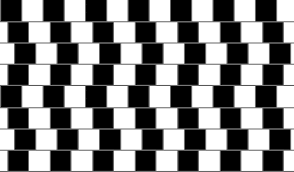Just a short post about two different types of clocks, inspired by a RadioLab podcast:
http://www.radiolab.org/2007/may/29/
Flower Clock
Many plants have a biological clock, which regulates the time of day that their flowers open and close. For example, the flowers of catmint (Nepeta cataria) - also known as catnip - open between 6am and 7am; orange hawkweed follows between 7am and 8am; field marigolds open at 9am and varieties of Helichrysum1 wake up for 10am. Other varieties follow, with Convolvulus opening at noon.
By making observations of the times when flowers open and close during the day, Carolus Linnaeus (the 18th-Century Swedish botanist, recognised as the father of taxonomy), conceived the idea of arranging certain plants in an order of flowering, so that they constituted a kind of floral clock. This was described in Linnaeus's Philosophia Botanica (1751) in which he referred to it as an horologium florae (floral clock). Apparently, Linnaeus was able to use his clock to determine the time accurately to within half an hour.
In Philosophia Botanica Linnaeus described three groups of flowers:
* Meteorici - flowers which change their opening and closing times according to the weather conditions.
* Tropici - flowers which change their times for opening and closing according to the length of the day.
* Aequinoctales - flowers which have fixed times for opening and closing. (Note that these are unaffected by the weather conditions.)
Only Aequinoctales are suitable for use in a flower clock.
Approx time Flower
0200 Night blooming cereus closes
0500 Morning glories, wild roses
0600 Spotted cat's ear, catmint
0700 African marigold, orange hawkweed, dandelions
0800 Mouse-ear hawkweed, African daisies
0900 Field marigold, gentians, prickly sowthistle closes
1000 Helichrysum, Californium poppy, common nipplewort closes
1100 Star of Bethlehem
1200 Passion flower, goatsbeard, morning glory closes
1300 Chiding pink closes
1400 Scarlet pimpernel closes
1500 Hawkbit closes
1600 'Four o'clock' plant2 opens, small bindweed closes, Californian poppy closes
1700 White waterlily closes
1800 Evening primrose, moonflower
1900
2000 Daylilies and dandelions close
2100 Flowering tobacco
2200 Night blooming cereus
http://scienceblogs.com/clock/2009/07/linaeus_floral_clock_on_the_is.php
...and another thing
A floral clock features in the fictional city of Quirm, in Soul Music, one of the books in Terry Pratchett's Discworld series.
To read more about Linnaeus' observations see this PDF.
Spice Clock
The spice clock, invented in the late seventeenth century by M. de Villayer. Intended to allow the user to tell the time in the absence of light, it guides the user to a different spice for each hour so that time may be told by taste (Boorstin, 1985). A quite interesting way to deal with this problem, the spice clock was made obsolete by illuminated clocks (source).
This kind of thing would actually be pretty easy to build actually... with a little electricity. Cinnamon for 1, coffee for 2..
Also, just ordered this book from Amazon as it seems pretty recommended. Time is obviously a really, really cool concept. Sometimes it goes fast, sometimes slow, sometimes subjectively, sometimes objectively. Since it's a dimension, of course you compare it to the other ones, and yeah, even our two and three dimensional worlds can be subjectively influenced over distance and balance, at the very least... Nevermind how a ruler changes shape over time and large distances!
... but, more on optical illusions later.. I swear I''ve been working on that post for half a year now.
Oh yeah, and more about time later too... just a sniff!
Sources if not mentioned directly:
Flower clock
http://solarclockgarden.truman.edu/garden.htm
http://www.bbc.co.uk/dna/h2g2/A5170024
http://en.wikipedia.org/wiki/Linnaeus%27_flower_clock
http://ces.iisc.ernet.in/hpg/envis/doc28.html
13 years ago







No comments:
Post a Comment